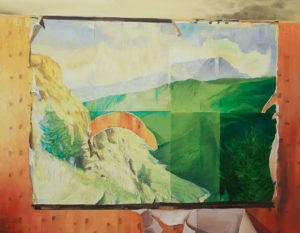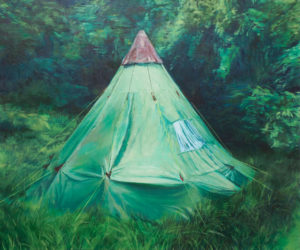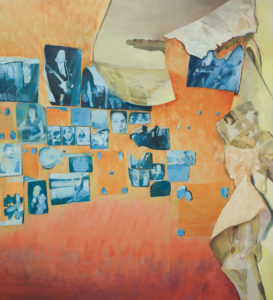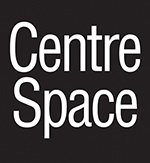
John Player
August 19 – September 9, 2017
Opening Saturday August 19th from 3pm to 6pm
Artist in attendance
What does it mean for an artist who has been preoccupied with landscape for the past five years to paint interiors? This body of work marks a shift in John Player’s methodology for a few reasons: he has come inside, to the realm of home and private life, and he has come closer, from disembodied aerial renderings of landscape to the deeply familiar scale of rooms and tents, things we measure with our bodies. He has also, for the first time, painted primarily from photographs he took himself, on a cycling trip through the Baltic states funded by the Brucebo Foundation.
Player, who has in the past taken up translating disposable images (stills from surveillance cameras, satellite views of landscape) to the seemingly more permanent medium of painting, is now rendering provisional domestic spaces whose precarity is a result of the same imperialism that he has been pointing at all along. This is his first exhibition that is comprised of more interiors than anything else, although most of the depicted spaces contain representations of landscape within them, in the form of faded posters or peeling wallpapered murals. Most of the interiors depict Skrunda-1, a former Soviet radar station in western Latvia, now a ghost town and, more recently, a burgeoning tourist attraction.[1]
In Recent Past 2, a swath of ripped wallpaper creates a confusion of surfaces within the logic of the picture plane. The eye hesitates between resting on the “real” depiction of a fragment of wallpaper, torn and hanging from a yellowed wall, and the space depicted in the wallpaper, a stream and some rocks amid slender tree trunks. The viewer understands that this is a representation of a representation, yet the temptation to see the forest as an alternate world beyond a dissolved surface isn’t easily shaken. It appears as though part of a blank wall has been peeled back to reveal a space has been willed into existence just beyond this bleak room in a military housing complex. There is pleasure in letting your focus slip beyond the logical surface that echoes the longing and nostalgia inherent in choosing to live with such depictions in the first place. 1994 depicts a different kind of desire for belonging—an adolescent’s longing for rebellion, for the twinned ideals of nihilism and hope, embodied by the Christ-like Kurt Cobain. Both the Recent Past series and 1994 point self-consciously at temporal markers. Depicting a last moment of the pre-internet era, these physical fragments of desire and escape suggest an alternate worldview, a fragile connective tissue between Russia and the West, one not visible on radar screens.
The images one chooses to live with reflect desire as well as cultural identity and taste; living with idealized representations of landscape may well be borne out of a desire for ownership over the land, the desire for connection and unity with the natural world exacerbated by a concurrent and increasing alienation from it. The romantic vistas featured on the walls of Skrunda’s apartment blocks expose a desire for the organic and the eternal, a fantasy of culture falling away. Yet the fact of their production and circulation also reveals depictions of land as emblematic of national identity, which became conflated with individual longing. Svetlana Boym wrote that “nostalgia is about the relationship between individual biography and the biography of groups and nation, between personal and collective memory.” And with Decommissioned, Player comes a little closer to revealing his own conflation of the personal and the collective. Painted from a photo found in a military archive of the Pinetree Line radar stations, the image could just as easily have come from Player’s family slide collection (his maternal grandfather worked for NORAD[2]). Most of the images in this archive sit uncomfortably on the border between official document and vernacular snapshot. Decommissioned depicts a ceremonial cake that is modeled after a radome; we aren’t quite sure if it is official military history, or an idiomatic record of a whimsical dessert.
If Player often chooses imagery that signals desire for control and ownership of the land, as well as nationhood and belonging, what does it mean for him to depict landscapes reproduced on wallpaper, or military equipment in the form of a cake? Spaces like Skrunda both clarify and complicate the connections between dwelling, representation, and socio-political conditions. Player’s work has been focused on geopolitics for several years now, but these depictions of domestic interiors point to a different facet of the relationship between land and power. The desire to master nature and control territory appears more innocuous (eerily so) in these feminized forms and environments.
Is this painting of a cake enough to say there has been a biographical turn in Player’s work? His previous work investigated the aesthetics of power by equating cool detachment with the capacity to obliterate, suppress, appropriate, and seize. After depicting images that were at once official and disposable, it’s as though he is now curious about the inverse—vernacular images authored by bodies, and real, visitable places that are both more tangible and less official. After so long dealing with ciphers, Player is now looking to remnants of material culture to try to bridge aesthetics of power and militarism to the lived and embodied experiences of individuals.
– Lise Latreille (08-2017)
[1] The trip through the Baltic states was funded by the Brucebo Foundation, Sweeden.
[2] North American Aerospace Defense Command
To view all the images of the show, click here
—
John Player was born in Victoria, BC in 1983. He holds a BFA in Studio Arts and a MFA in Painting and Drawing from Concordia University. He has participated in various group exhibitions in Montreal, where he has worked and lived since 2004. John was part of the Baie St-Paul Symposium in 2015 and of the Art Omi (NY) residency programme. In 2016, he was awarded the William Blair Bruce Travel Scholarship to undertake research cycling through former Soviet Republics. Finalist of the RBC Painting Competition in 2015, his work can found in numerous private collections and in the corporate collections of Groupe Courchesne Larose and BMO Financial Group.
– John Player’s web site.
– John Player’s artist page on the gallery website.
– Bill Clarke, ” STUDIO VIEW : John Player “, Magenta Foundation
The Gallery thanks SODEC for its support.

John Player
Shelter, 2016
Oil on canvas
83.8 x 1106.7 cm (33″ x 42″)

John Player
1994, 2016
Oil on canvas
76.2 x 83.8 cm (30″ x 33″)
Top image: Backdrop, 2016, 83.8 x 106.7 cm (33″ x 42″)
